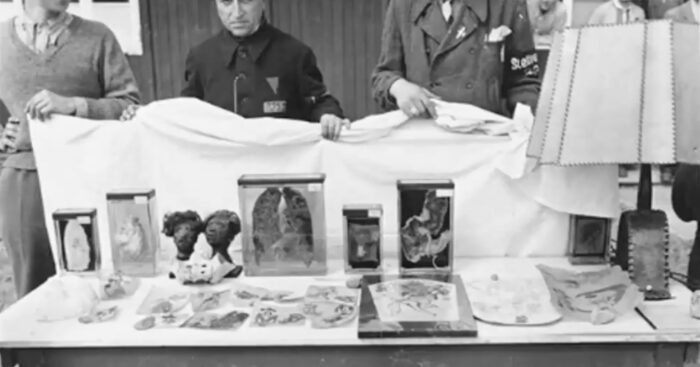Lampshades, of Human Skin
There are plenty of photographs and film footage of tattooed human skin, allegedly taken from deceased or murdered inmates of German wartime camps. Especially famous is film footage recorded by U.S. troops after liberating the Buchenwald Camp. They had set up a table there, onto which they had arranged all kinds of objects which were allegedly made of dead or murdered inmates: preserved human organs, a table lamp, two shrunken heads, tattooed skin etc. The local population was forced to walk by this table for “educational purposes.” It was an operation staged by the United States’ psychological warfare department (see Irebodd 2009). The scenes were filmed and later used to further “re-educate” the German populace by showing this footage all over the country in cinemas. If Germans did not watch these “documentaries,” the Allied authorities would deny them food stamps, which for many were pivotal for survival in the immediate post-war years.

This “documentary” and the objects, as well as an expert report by a pathologist of the U.S. Army of May 1946, served later as evidence during the Dachau show trial against the staff of the Buchenwald Camp, and during the trials of Ilse Koch, the wife of the former camp commandant of the Buchenwald Camp. She is supposed to have selected living prisoners in the camp according to their tattooing, and designated them for killing in order to have household objects produced from their skin.
In an interview that SS judge Konrad Morgen granted U.S. historian John Toland years after the war, he insisted that the stories about Ilse Koch using tattooed human skin for lampshades and other object were unfounded legends. He had searched the Koch household himself during the war when investigating crimes committed by Ilse’s husband Karl-Otto Koch, former commandant of the Buchenwald Camp, without finding any such objects. (See Toland 1976, pp. 845f.)
In a detailed study, U.S. mainstream author Arthur L. Smith determined that the objects identified as human skin by a U.S. examination, after they were sent to the International Military Tribunal at Nuremberg, disappeared without a trace (Smith 1983, pp. 103, 138, 153, 164). According to the statement of General Clay of the U.S. Army, the alleged human-skin lampshades are supposed to have consisted of goatskin (ibid., p. 227). All other objects found later were said to have been made either of synthetic leather, animal leather, textile or cardboard.
Only some 70 years after the war did DNA testing reach such sophisticated levels that decade-old samples which had been heavily processed with heat and chemicals could be analyzed. Samples submitted by the Buchenwald Museum to a forensic pathologist turned out to consist of human skin, indeed. The skin’s origin is unknown, however, and none of these items analyzed consisted of tattooed skin.
The story has a somewhat innocuous background. There evidently was an SS officer on the camp staff who was at the same time pursuing a PhD in medicine at the University of Jena. His medical dissertation investigated a possible correlation between skin tattooing and criminality (Smith 1983, pp. 127f.). This thesis was briefly mentioned in yet another PhD thesis some 65 years later on the history of forensic medicine at the University of Jena (Bode 2007, pp. 106f.). There is no credible evidence that inmates were killed for the sake of their tattoos, though.
Another PhD thesis on the prevalence of preserved tattooed human skin in museums around the world sheds light on the widespread use (and misuse) of human skin before the rise of universally recognized civil rights (Angel 2013; see also Rudolf 2025). That puts this lurid topic in a wider context.
It needs to be kept in mind that none of the objects presumably created from body parts of deceased inmates involved Jews. At the time when this is said to have happened – during the time when Karl-Otto Koch was the camp’s commandant, hence until August 1942 (see the entry on him) – Buchenwald housed hardened criminals, political prisoners and resistance fighters/partisans, but not Jews. Koch was investigated by the SS internal court system and eventually arrested for various infractions. When rumors claiming the exploitation of deceased inmates’ bodies reached Himmler in late 1942, he strictly prohibited this and ordered an investigation. Hence, if inmate skin was ever used for anything, it was considered an abhorrent crime even back then.
(For more details, see Rudolf 2023, pp. 94-97; Rudolf 2025; see also the entry on Hans Maršálek.)

You need to be a registered user, logged into your account, and your comment must comply with our Acceptable Use Policy, for your comment to get published. (Click here to log in or register.)